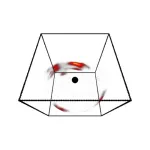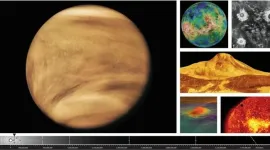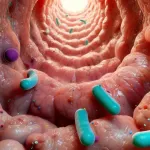(Press-News.org) Scientists believe the environment immediately surrounding a black hole is tumultuous, featuring hot magnetized gas that spirals in a disk at tremendous speeds and temperatures. Astronomical observations show that within such a disk, mysterious flares occur up to several times a day, temporarily brightening and then fading away. Now a team led by Caltech scientists has used telescope data and an artificial intelligence (AI) computer-vision technique to recover the first three-dimensional video showing what such flares could look like around Sagittarius A* (Sgr A*, pronounced sadge-ay-star), the supermassive black hole at the heart of our own Milky Way galaxy.
The 3D flare structure features two bright, compact features located about 75 million kilometers (or half the distance between Earth and the Sun) from the center of the black hole. It is based on data collected by the Atacama Large Millimeter Array (ALMA) in Chile over a period of 100 minutes directly after an eruption seen in X-ray data on April 11, 2017.
"This is the first three-dimensional reconstruction of gas rotating close to a black hole," says Katie Bouman, assistant professor of computing and mathematical sciences, electrical engineering and astronomy at Caltech, whose group led the effort described in a new paper in Nature Astronomy.
Aviad Levis, a postdoctoral scholar in Bouman's group and lead author on the new paper, emphasizes that while the video is not a simulation, it is also not a direct recording of events as they took place. "It is a reconstruction based on our models of black hole physics. There is still a lot of uncertainty associated with it because it relies on these models being accurate," he says.
Using AI informed by physics to figure out possible 3D structures
To reconstruct the 3D image, the team had to develop new computational imaging tools that could, for example, account for the bending of light due to the curvature of space-time around objects of enormous gravity, such as a black hole.
The multidisciplinary team first considered if it would be possible to create a 3D video of flares around a black hole in June 2021. The Event Horizon Telescope (EHT) Collaboration, of which Bouman and Levis are members, had already published the first image of the supermassive black hole at the core of a distant galaxy, called M87, and was working to do the same with EHT data from Sgr A*. Pratul Srinivasan of Google Research, a co-author on the new paper, was at the time visiting the team at Caltech. He had helped develop a technique known as neural radiance fields (NeRF) that was then just starting to be used by researchers; it has since had a huge impact on computer graphics. NeRF uses deep learning to create a 3D representation of a scene based on 2D images. It provides a way to observe scenes from different angles, even when only limited views of the scene are available.
The team wondered if, by building on these recent developments in neural network representations, they could reconstruct the 3D environment around a black hole. Their big challenge: From Earth, as anywhere, we only get a single viewpoint of the black hole.
The team thought that they might be able to overcome this problem because gas behaves in a somewhat predictable way as it moves around the black hole. Consider the analogy of trying to capture a 3D image of a child wearing an inner tube around their waist. To capture such an image with the traditional NeRF method, you would need photos taken from multiple angles while the child remained stationary. But in theory, you could ask the child to rotate while the photographer remained stationary taking pictures. The timed snapshots, combined with information about the child's rotation speed, could be used to reconstruct the 3D scene equally well. Similarly, by leveraging knowledge of how gas moves at different distances from a black hole, the researchers aimed to solve the 3D flare reconstruction problem with measurements taken from Earth over time.
With this insight in hand, the team built a version of NeRF that takes into account how gas moves around black holes. But it also needed to consider how light bends around massive objects such as black holes. Under the guidance of co-author Andrew Chael of Princeton University, the team developed a computer model to simulate this bending, also known as gravitational lensing.
With these considerations in place, the new version of NeRF was able to recover the structure of orbiting bright features around the event horizon of a black hole. Indeed, the initial proof-of-concept showed promising results on synthetic data.
A flare around Sgr A* to study
But the team needed some real data. That's where ALMA came in. The EHT's now famous image of Sgr A* was based on data collected on April 6–7, 2017, which were relatively calm days in the environment surrounding the black hole. But astronomers detected an explosive and sudden brightening in the surroundings just a few days later, on April 11. When team member Maciek Wielgus of the Max Planck Institute for Radio Astronomy in Germany went back to the ALMA data from that day, he noticed a signal with a period matching the time it would take for a bright spot within the disk to complete an orbit around Sgr A*. The team set out to recover the 3D structure of that brightening around Sgr A*.
ALMA is one of the most powerful radio telescopes in the world. However, because of the vast distance to the galactic center (more than 26,000 light-years), even ALMA does not have the resolution to see Sgr A*'s immediate surroundings. What ALMA measures are light curves, which are essentially videos of a single flickering pixel, which are created by collecting all of the radio-wavelength light detected by the telescope for each moment of observation.
Recovering a 3D volume from a single-pixel video might seem impossible. However, by leveraging an additional piece of information about the physics that are expected for the disk around black holes, the team was able to get around the lack of spatial information in the ALMA data.
Strongly polarized light from the flares provided clues
ALMA doesn’t just capture a single light curve. In fact, it provides several such "videos" for each observation because the telescope records data relating to different polarization states of light. Like wavelength and intensity, polarization is a fundamental property of light and represents which direction the electric component of a light wave is oriented with respect to the wave's general direction of travel. "What we get from ALMA is two polarized single-pixel videos," says Bouman, who is also a Rosenberg Scholar and a Heritage Medical Research Institute Investigator. "That polarized light is actually really, really informative."
Recent theoretical studies suggest that hot spots forming within the gas are strongly polarized, meaning the light waves coming from these hot spots have a distinct preferred orientation direction. This is in contrast to the rest of the gas, which has a more random or scrambled orientation. By gathering the different polarization measurements, the ALMA data gave the scientists information that could help localize where the emission was coming from in 3D space.
Introducing Orbital Polarimetric Tomography
To figure out a likely 3D structure that explained the observations, the team developed an updated version of its method that not only incorporated the physics of light bending and dynamics around a black hole but also the polarized emission expected in hot spots orbiting a black hole. In this technique, each potential flare structure is represented as a continuous volume using a neural network. This allows the researchers to computationally progress the initial 3D structure of a hotspot over time as it orbits the black hole to create a whole light curve. They could then solve for the best initial 3D structure that, when progressed in time according to black hole physics, matched the ALMA observations.
The result is a video showing the clockwise movement of two compact bright regions that trace a path around the black hole. "This is very exciting," says Bouman. "It didn't have to come out this way. There could have been arbitrary brightness scattered throughout the volume. The fact that this looks a lot like the flares that computer simulations of black holes predict is very exciting."
Levis says that the work was uniquely interdisciplinary: "You have a partnership between computer scientists and astrophysicists, which is uniquely synergetic. Together, we developed something that is cutting edge in both fields—both the development of numerical codes that model how light propagates around black holes and the computational imaging work that we did."
The scientists note that this is just the beginning for this exciting technology. "This is a really interesting application of how AI and physics can come together to reveal something that is otherwise unseen," says Levis. "We hope that astronomers could use it on other rich time-series data to shed light on complex dynamics of other such events and to draw new conclusions."
The new paper is titled, "Orbital Polarimetric Tomography of a Flare Near the Sagittarius A* Supermassive Black Hole." The work was supported by funding from the National Science Foundation, the Carver Mead New Adventures Fund at Caltech, the Princeton Gravity Initiative, and the European Research Council.
END
AI and physics combine to reveal the 3D structure of a flare erupting around a black hole
2024-04-22
ELSE PRESS RELEASES FROM THIS DATE:
NFL PLAY 60 Fitness Break delivers movement to classrooms in advance of the NFL Draft
2024-04-22
DALLAS, April 22, 2024 — The American Heart Association, celebrating 100 years of lifesaving service, and the National Football League (NFL), in collaboration with its 32 NFL clubs, are challenging kids to get moving to support mental and physical health with the latest installment of NFL PLAY 60 Fitness Break broadcast series leading up to the live Draft coverage from Detroit. On Thursday, April 25 at 1 p.m. ET/ 12 p.m. CT/ 10 a.m. PT the NFL PLAY 60 Draft Fitness Break broadcast will assist kids in getting their daily 60 minutes ...
To find life in the universe, look to deadly Venus
2024-04-22
Despite surface temperatures hot enough to melt lead, lava-spewing volcanoes, and puffy clouds of sulfuric acid, uninhabitable Venus offers vital lessons about the potential for life on other planets, a new paper argues.
“We often assume that Earth is the model of habitability, but if you consider this planet in isolation, we don’t know where the boundaries and limitations are,” said UC Riverside astrophysicist and paper first author Stephen Kane. “Venus gives us that.”
Published today in the journal Nature Astronomy, the paper compiles much of the known information about Earth and Venus. ...
This alloy is kinky
2024-04-22
A metal alloy composed of niobium, tantalum, titanium, and hafnium has shocked materials scientists with its impressive strength and toughness at both extremely hot and cold temperatures, a combination of properties that seemed so far to be nearly impossible to achieve. In this context, strength is defined as how much force a material can withstand before it is permanently deformed from its original shape, and toughness is its resistance to fracturing (cracking). The alloy’s resilience to bending and fracture across an enormous range of conditions could open the door for a novel class of materials for next-generation engines that can operate at higher ...
Online tools can help to lower costs for urologic medications
2024-04-22
Waltham — April 19, 2024 — Available online tools can help to lower out-of-pocket prescription drug costs for patients with common urologic conditions, reports a study in the May issue of Urology Practice®, an Official Journal of the American Urological Association (AUA). The journal is published in the Lippincott portfolio by Wolters Kluwer.
"As clinicians, we find that many patients need help in understanding that prescriptions can often be purchased outside of insurance for significantly lower cost and in ...
Despite AI advancements, human oversight remains essential
2024-04-22
New York, NY [April 22, 2024]—State-of-the-art artificial intelligence systems known as large language models (LLMs) are poor medical coders, according to researchers at the Icahn School of Medicine at Mount Sinai. Their study, published in the April 19 online issue of NEJM AI [DOI: 10.1056/AIdbp2300040], emphasizes the necessity for refinement and validation of these technologies before considering clinical implementation.
The study extracted a list of more than 27,000 unique diagnosis and procedure codes from 12 months of routine care ...
Gut bacteria and inflammatory bowel disease: a new frontier in treatment
2024-04-22
A growing body of research suggests that manipulating gut bacteria may offer a promising approach to managing inflammatory bowel disease (IBD), a chronic and debilitating condition affecting millions of people worldwide.
IBD, encompassing Crohn's disease, ulcerative colitis, and unclassified IBD, is characterized by chronic inflammation of the digestive tract. Conventional treatments aim to control symptoms and prevent complications. However, they often have limited effectiveness and can come with side effects.
This new research explores the potential of prebiotics, dietary fibers that nourish ...
Critical gap in colorectal cancer screening process: follow-up after positive stool test
2024-04-22
INDIANAPOLIS – Screening for colorectal cancer presents a unique opportunity unavailable for most other types of cancers. Screening allows for the detection of both precancerous polyps and cancer, enabling clinicians to intervene and reduce the chances of future development of new or more advanced malignancy. However, gaps in the colorectal screening process exist. One of the most critical gaps, according to an editorial published in JAMA Network Open, is the lack of timely follow-up with a colonoscopy after a positive stool-based test.
A positive ...
Ion thermoelectric conversion devices for near room temperature
2024-04-22
They published their work on Apr. 10 in Energy Material Advances.
The electrode sheet of the thermoelectric device consists of ionic hydrogel, which is sandwiched between the electrodes to form, and the Prussian blue on the electrode undergoes a redox reaction to improve the energy density and power density of the ionic thermoelectric generator.
Prof. Zeng Wei of the Institute of Chemical Engineering, Guangdong Academy of Sciences, said that at the beginning, the group mainly carried out research based on the thermal diffusion effect and published a series of research results. In spite of this, their results never realized the ...
SwRI-led eclipse projects shed new light on solar corona
2024-04-22
SAN ANTONIO — April 22, 2024 —Teams led by Southwest Research Institute successfully executed two groundbreaking experiments — by land and air — collecting unique solar data from the total eclipse that cast a shadow from Texas to Maine on April 8, 2024. The Citizen Continental-America Telescopic Eclipse (CATE) 2024 experiment engaged more than 200 community participants in a broad, approachable and inclusive attempt to make a continuous 60-minute high-resolution movie of this exciting event. A nearly simultaneous investigation used unique equipment installed in NASA’s WB-57F research aircraft to chase the ...
Analyzing the impact of ovulation-inducing agents on the quality of embryo
2024-04-22
Low birth rates have become a serious problem in many developed countries throughout the world, with Japan being a prime example. In Japan particularly, aging and stress have led to a massive rise in infertility, which now affects one in every 4.4 couples. To find a workaround this condition, many couples have now turned to assisted reproduction technologies (ARTs) and in vitro fertilization (IVF) for conception. However, even though ARTs and IVF methods are well-established and have been widely used for over four decades, birth rates post IVF in Japan are still critically low, peaking at a meager 10.2%.
One of the reasons ...









